Arizona is home to a fascinating variety of scorpions, with many species uniquely adapted to its diverse landscapes. Understanding the different types of scorpions in Arizona is important for both enthusiasts and residents alike, as it helps with identification and awareness of their behaviors and habitats.
This article presents 43 types of scorpions in Arizona, featuring clear pictures and detailed descriptions to assist with identification. From common desert inhabitants to rare mountain dwellers, each species brings a unique element to Arizona’s rich scorpion diversity.
For anyone interested in the natural world or seeking to learn more about these intriguing creatures, this guide to the types of scorpions in Arizona offers valuable insights. Discover where these scorpions live, how to recognize them, and what sets each species apart.
Different Types of Scorpions in Arizona
Superstition Mountains Scorpion (Superstitionia donensis)
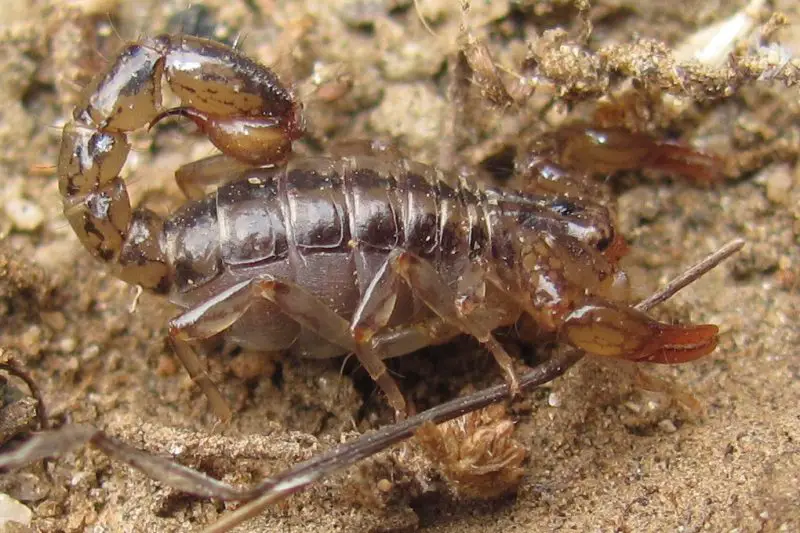
The Superstition Mountains scorpion (Superstitionia donensis) is a rare species first identified in Arizona in 1940. It inhabits the rugged terrain of the Superstition Mountains and is closely associated with rocky desert environments. Its preference for high-elevation desert areas makes it less commonly encountered than other local species.
Physically, it is a small scorpion with a dark body and subtle patterning. It often hides beneath rocks or close to desert plants to avoid the sun’s heat. Its venom has been the subject of scientific research, as it is chemically distinct from that of other Arizona scorpions, though it is not more toxic.
Though stings from the Superstition Mountains scorpion may cause local swelling and pain, they are not medically severe. Due to its restricted range and discreet habits, it is seldom seen by the public. Nonetheless, it remains an interesting example of Arizona’s unique desert biodiversity.
Santa Rita Scorpion (Pseudouroctonus santarita)
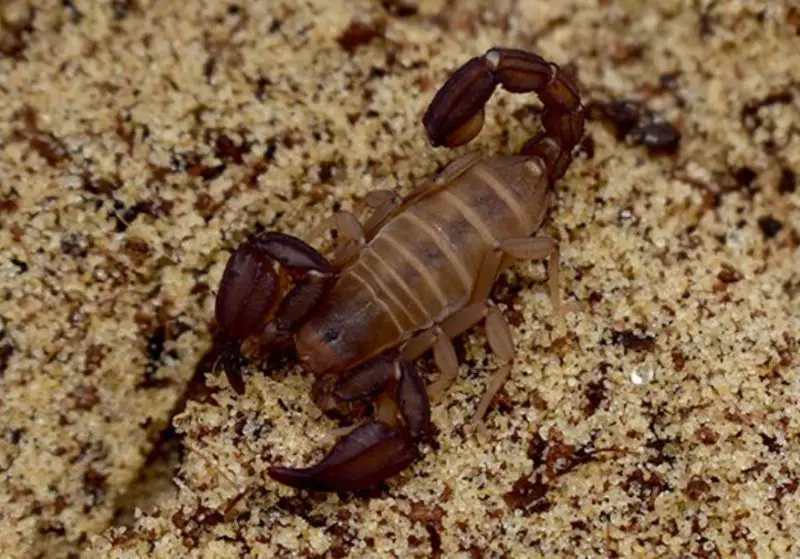
The Santa Rita scorpion (Pseudouroctonus santarita) is a small and elusive species that belongs to the Vaejovidae family. This scorpion is native to Arizona and is mainly found in the Santa Rita Mountains, a rugged range in the southern part of the state. Its elusive nature makes it a rarely observed species in the wild.
These scorpions are nocturnal and spend their days hidden under rocks, logs, or other natural cover to escape the daytime heat. They emerge at night to hunt for insects and other small invertebrates. Due to their size and discreet habits, they are not frequently encountered by hikers or researchers.
Because of their rarity and secluded habitat, there is limited information available on this species. However, like other members of its genus, the Santa Rita scorpion is presumed to have a mild venom and plays a beneficial role in maintaining ecological balance by preying on pest insects in its mountainous habitat.
Arizona Smoothclaw Scorpion (Diplocentrus spitzeri)
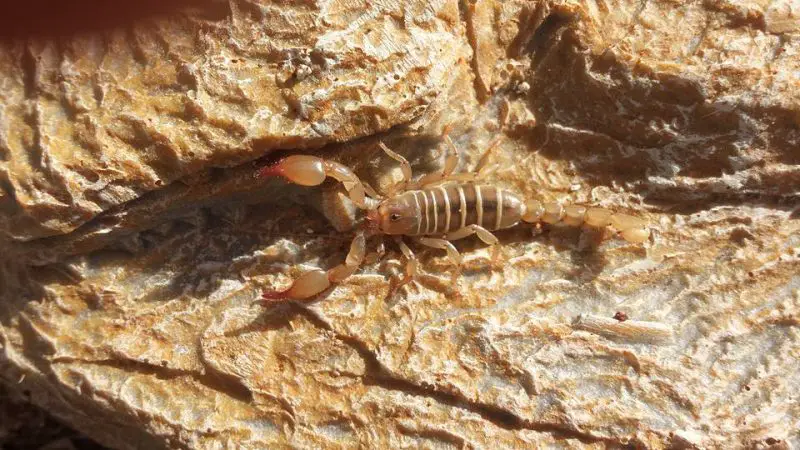
The Arizona smoothclaw scorpion (Diplocentrus spitzeri) is a sturdy species recognized by its relatively large pincers and distinct coloration. It can reach up to 5.2 centimeters in length and typically has a dark brown body with contrasting yellowish legs. These color patterns help it blend into its desert surroundings.
This species is widely distributed throughout Arizona and prefers hiding in cool, shaded areas during the day. Common shelters include spaces under rocks, beneath bark, and among leaf litter. Its broad, smooth claws give it a unique appearance compared to many other Arizona scorpions.
The Arizona smoothclaw scorpion is not considered dangerous to humans. Its venom is mild, and stings are uncommon due to its reclusive behavior. It is an important predator of insects and plays a vital role in controlling populations of other invertebrates in desert ecosystems.
Apache Scorpion (Pseudouroctonus apacheanus)
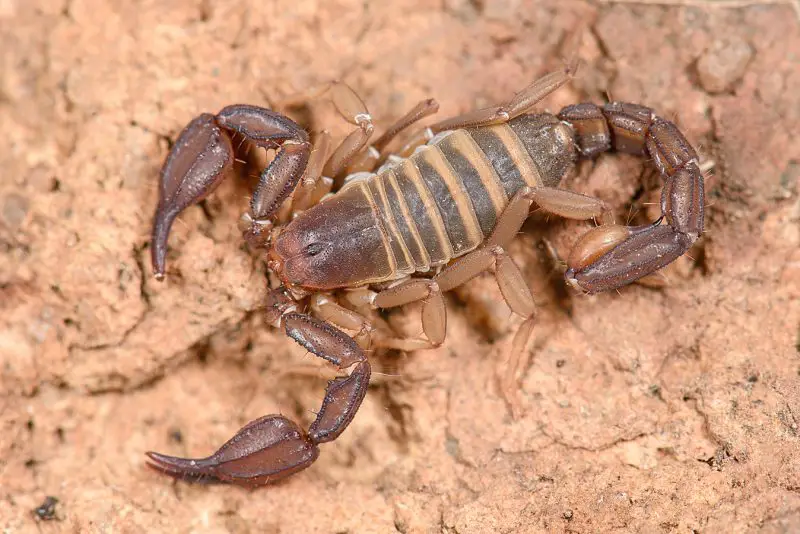
The Apache scorpion (Pseudouroctonus apacheanus) is a rare species found in the Baboquivari Mountains of southern Arizona. Its range extends into New Mexico and northern Mexico, but sightings remain infrequent, making it one of the lesser-known scorpions in the region.
This scorpion belongs to the Vaejovidae family and is typically active at night. During daylight hours, it seeks shelter in crevices or under debris to avoid the heat. Due to its nocturnal lifestyle and remote habitat, little detailed research has been conducted on its behavior or venom.
Though little is known about its ecological role, it likely follows a similar pattern to related species—feeding on insects and remaining out of sight during the hottest parts of the day. Its presence in high-elevation desert areas highlights the biodiversity found in southern Arizona’s mountain ranges.
Dune Scorpion (Smeringurus mesaensis)
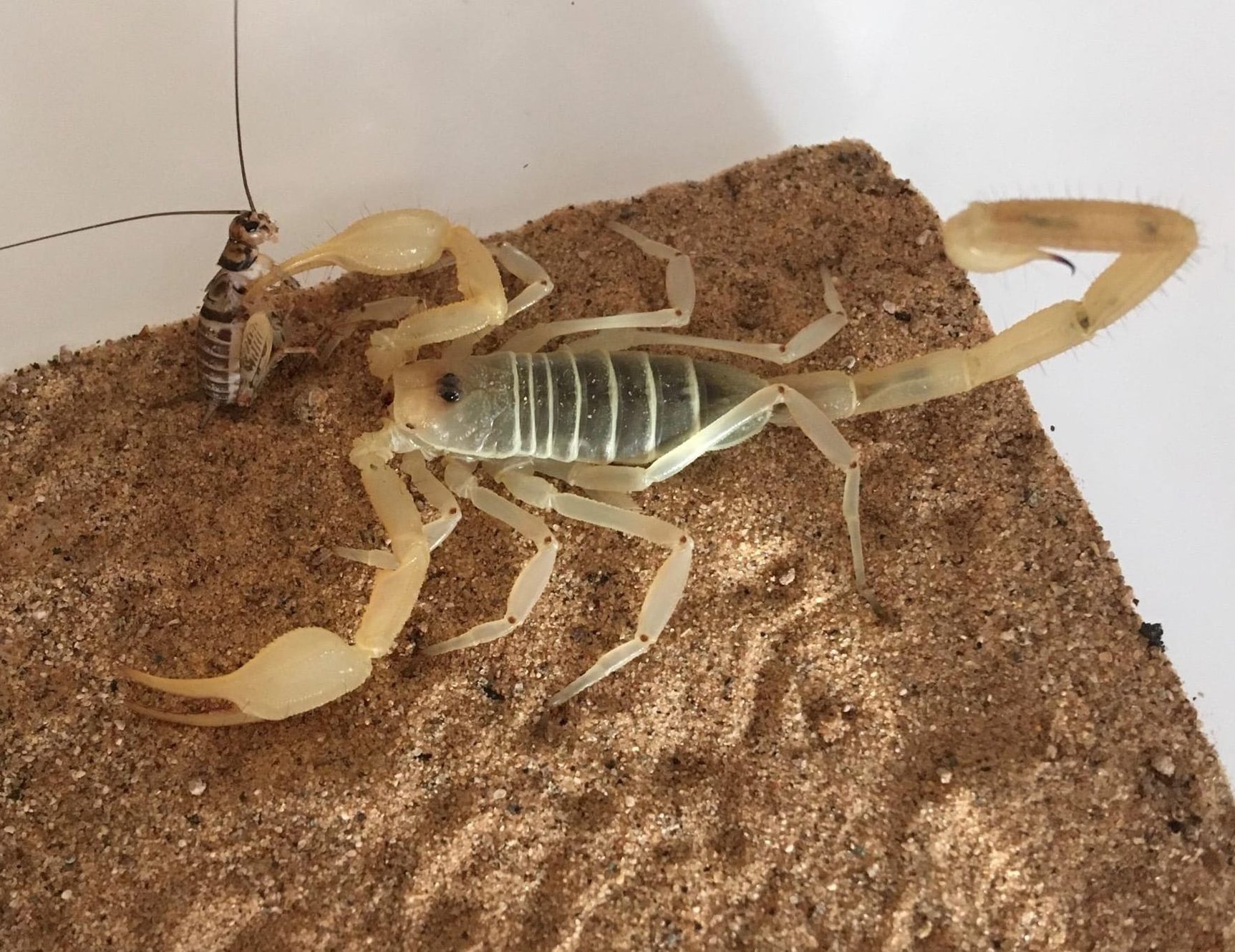
The dune scorpion (Smeringurus mesaensis), also known as the giant sand scorpion, is a robust species adapted to the harsh desert climates of the southwestern United States. Growing up to 7.2 centimeters in length, it is one of the larger scorpions in Arizona and is part of the Vaejovidae family.
This species is typically found in arid, sandy environments such as dunes and desert flats. It is solitary in nature, and females are usually larger than males. Dune scorpions use their burrowing abilities to create shelter in loose sand and are most active at night when temperatures are cooler.
Despite its size and formidable appearance, the sting of the dune scorpion is not considered medically significant to humans. It relies on ambush tactics to capture prey such as insects and spiders, making it an important predator in desert ecosystems.
Cash’s Scorpion (Vaejovis cashi)
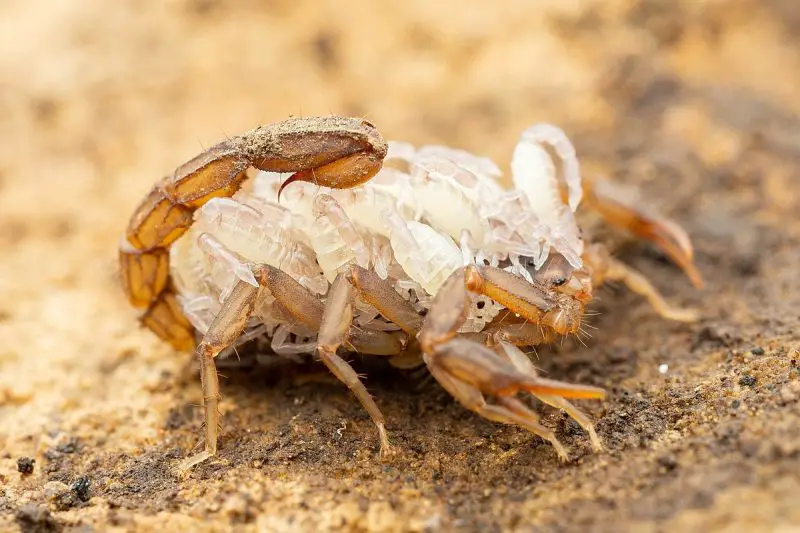
Cash’s scorpion (Vaejovis cashi) is a species endemic to Arizona, specifically found in the Chiricahua Mountains in Cochise County. It belongs to the Vaejovidae family and is adapted to the unique conditions of southeastern Arizona’s mountainous terrain.
This species tends to stay well hidden during the day, often burrowing beneath rocks or plant debris to avoid the desert heat. It emerges at night to feed on insects and other small arthropods. Due to its secluded habits and limited range, it is rarely encountered by people.
Although sightings are rare, Cash’s scorpion contributes to the local ecosystem by serving as both predator and prey. Its venom is not considered medically significant, and like many scorpions in Arizona, it plays a quiet but essential role in controlling insect populations.
Vorhies’ Scorpion (Vaejovis vorhiesi)

Vorhies’ scorpion (Vaejovis vorhiesi) is a small and elusive species of the Vaejovidae family, known to be endemic to Arizona. This scorpion is primarily found in the Huachuca Mountains in Cochise County, a region rich in biodiversity and home to several unique scorpion species.
Males of this species grow up to 2.6 centimeters in length, while females can exceed 3 centimeters. Their relatively small size and secretive habits make them difficult to spot in the wild, contributing to the limited number of recorded sightings.
These nocturnal predators remain hidden during the day, emerging at night to hunt for insects and other small arthropods. Despite their scarcity, Vorhies’ scorpions play an important ecological role in maintaining the balance of desert insect populations.
Vaejovis deboerae (Vaejovis deboerae)
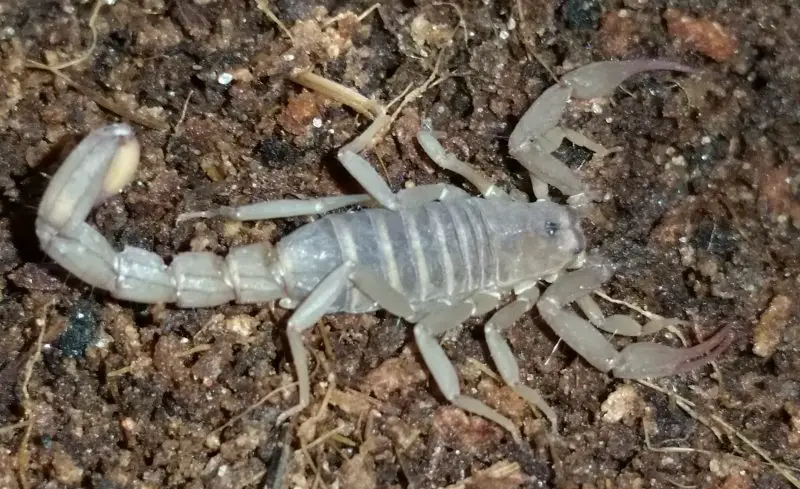
Vaejovis deboerae is a recently discovered species in the Vaejovidae family, first identified in 2013 in the Santa Catalina Mountains of Arizona. It was the tenth mountain scorpion to be discovered in the state and only the second known to inhabit this specific range.
This small species is adapted to mountainous habitats, and females can grow up to 2.7 centimeters in length. One of their notable traits is reproductive behavior—females carry up to 24 offspring on their back after birth, a characteristic feature of many scorpions.
Due to its recent discovery, detailed information on its behavior and habitat preferences is still emerging. Nevertheless, Vaejovis deboerae adds to the growing list of unique scorpion species found only in Arizona’s sky island mountain ranges.
Stripe-tailed Scorpion (Paravaejovis spinigerus)

The stripe-tailed scorpion, also known as the devil scorpion (Paravaejovis spinigerus), is a medium-sized species commonly found in Arizona. Adults typically grow up to 7 centimeters and have dark, defined stripes running across the top of their thick tails. Their tail structure is more robust compared to species like the bark scorpion, which makes them easier to recognize.
These scorpions often display a tan to golden brown body color, with faint dusky patches on their tails. Their appearance varies slightly depending on the local environment, but their banded tails remain a consistent identification feature. Though their venom is not highly dangerous, they may sting if provoked, usually resulting in localized pain.
In Arizona, stripe-tailed scorpions are especially common in the Sonoran Desert. They prefer sheltered, dark places such as beneath rocks, inside shoes, or tucked away in sleeping bags. Most encounters occur during warmer months when they become more active at night while searching for prey or moisture.
Arizona Bark Scorpion (Centruroides sculpturatus)
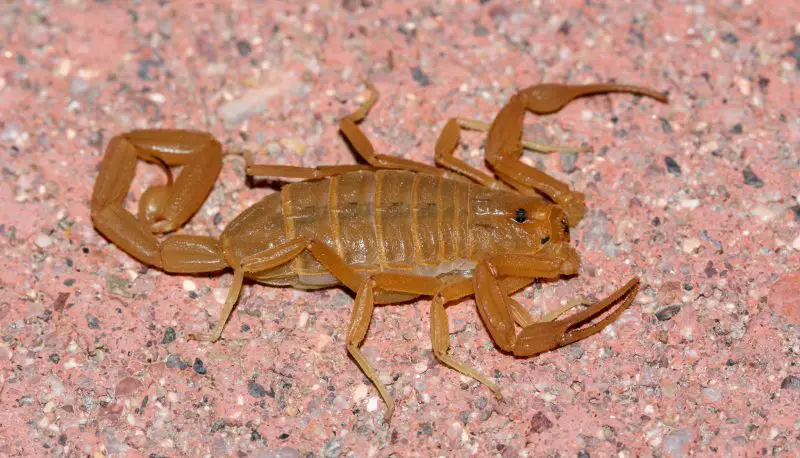
The Arizona bark scorpion (Centruroides sculpturatus) is the most venomous scorpion in North America and is easily recognized by its slender body and light tan coloration. Adult males reach about 8 centimeters in length, while females are usually around 1 centimeter smaller. Their waxy exoskeleton is adapted for desert living by minimizing water loss.
This nocturnal species often hides during the day in crevices, under tree bark, or inside homes, especially in the summer. One unique behavior is their tendency to hang upside down under surfaces, which often leads to accidental stings when objects are lifted or handled unknowingly. They are common household intruders in southern Arizona.
The venom of the Arizona bark scorpion can cause intense pain, numbness, vomiting, and in some cases, temporary paralysis. Although fatalities are rare—with only two recorded deaths in Arizona since 1968—thousands of sting cases are reported annually. Medical attention is often recommended, especially for children, the elderly, or those with allergic reactions.
Arizona Desert Hairy Scorpion (Hadrurus arizonensis)
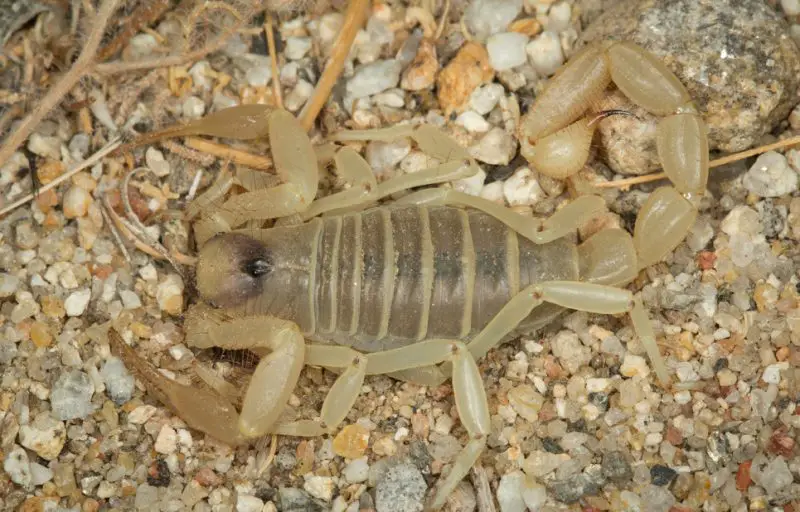
The Arizona desert hairy scorpion (Hadrurus arizonensis), also referred to as the giant hairy scorpion, is the largest scorpion species in North America, growing up to 14 centimeters in length. It is easily identified by its thick body covered in fine hairs and a yellow underside with a darker back. Its strong pincers make it an efficient predator in desert environments.
This species is a solitary burrower, often found in dry, sandy areas of Arizona, where it digs deep to find cooler and moister soil. It usually hides under rocks and emerges at night to hunt. Though its sting is very painful, it is not typically dangerous to humans unless an allergic reaction occurs.
Arizona desert hairy scorpions are known for their aggressive behavior when disturbed. Their preferred habitats include open desert, grasslands, and areas with scattered vegetation. Despite their intimidating size, they are generally elusive during the day and rely on their sense of vibration to detect prey or danger.
Yellow Devil Scorpion (Paravaejovis confusus)

The yellow devil scorpion (Paravaejovis confusus) is a small desert species native to Arizona. Most sightings occur during the warmer months of June and September, especially following monsoon activity or during warm nights. It is often found in dry, sandy, and rocky environments with sparse cover.
This species is pale yellow, giving it excellent camouflage against desert sands. Though small, it can still deliver a sting, but its venom is not considered medically significant. As with other scorpions, stings may cause temporary discomfort or swelling but rarely lead to complications.
Yellow devil scorpions are reclusive and prefer to remain hidden under rocks, logs, or plant debris during daylight hours. Their nocturnal habits make them difficult to spot, but they play an important ecological role in controlling insect populations in the arid landscapes of Arizona.
Stahnkeus Subtilimanus (Stahnkeus subtilimanus)

Stahnkeus subtilimanus (Stahnkeus subtilimanus) is a little-known member of the Vaejovidae family that occurs in southwestern Arizona. Males of this species grow up to 3.5 centimeters, while females are slightly larger, reaching up to 4.18 centimeters.
This nocturnal scorpion spends the day hiding under rocks, bark, and other natural debris to escape the desert sun. It emerges at night to actively search for prey, using its pincers and venomous sting to subdue small invertebrates.
Due to its relatively limited range and discreet habits, Stahnkeus subtilimanus is not often observed in the wild. It represents another fascinating species that showcases the biodiversity of Arizona’s scorpion fauna.
Vaejovis grahami (Vaejovis grahami)
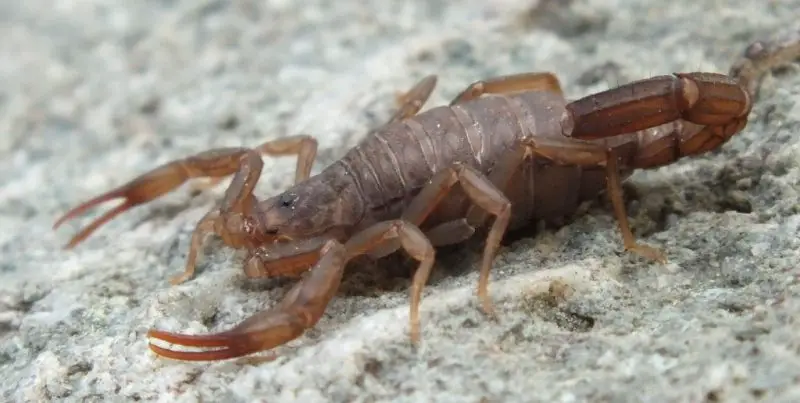
Vaejovis grahami (Vaejovis grahami) is a small brown scorpion recently identified in the Santa Rita Mountains, located in Santa Cruz County, Arizona. As a member of the Vaejovidae family, it closely resembles other mountain scorpions found in southern Arizona.
Although newly discovered, this species is believed to share many behavioral and ecological traits with related species. It is nocturnal, hiding by day and emerging at night to hunt insects and other prey in its mountainous habitat.
Its discreet habits and resemblance to other Vaejovis species make identification challenging in the field. Nevertheless, Vaejovis grahami contributes to Arizona’s reputation as a hotspot for scorpion diversity, particularly in its sky island ecosystems.
Walnut Gulch Scorpion (Serradigitus miscionei)

The Walnut Gulch scorpion (Serradigitus miscionei) is a rare and localized species, known only from southern Arizona. It is one of just three Serradigitus species documented in the state, and was first discovered in 2011 during lizard surveys near the San Pedro River.
This scorpion is small in size, with females reaching up to 2.5 centimeters in length including the tail. It is typically red to brown in coloration, which helps it blend into its arid surroundings, such as rocky washes and canyon walls.
Due to its rarity and narrow distribution, very little is known about its natural history. However, its discovery added to the growing list of unique and endemic scorpions in Arizona, a state known for its rich scorpion biodiversity.
Black-back Scorpion (Hadrurus spadix)
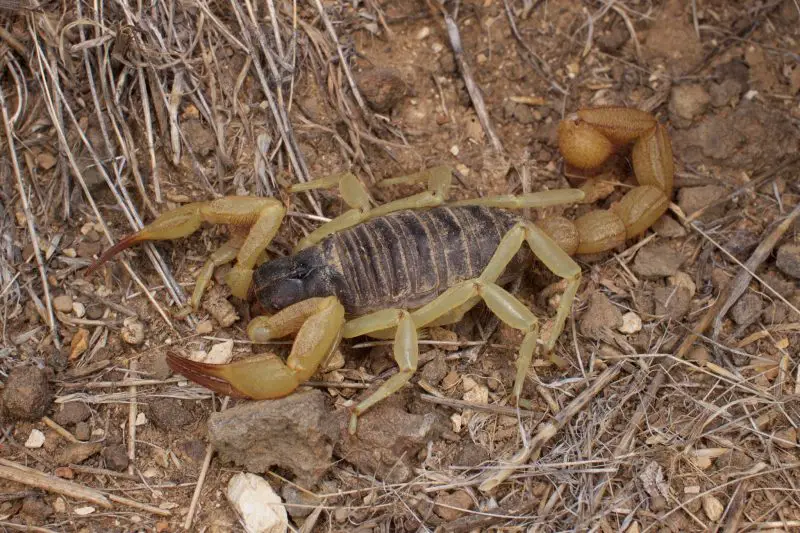
The Black-back Scorpion (Hadrurus spadix) is one of the largest scorpion species found in North America, particularly in the deserts of the southwestern United States. It can grow up to 15 centimeters (5.5 inches) in length and is distinguished by its pale yellow body contrasted with a dark stripe running down the back, hence the name “black-back.”
This scorpion is a skilled burrower, spending most of the day digging and hiding in tunnels beneath the desert surface. These burrows help protect it from extreme temperatures and predators. It emerges at night to feed on insects and other small invertebrates using its powerful pincers and quick reflexes.
Although it is sometimes kept as a pet by experienced arachnid hobbyists, the Black-back Scorpion is naturally nervous and will show aggression if disturbed. Its venom is of low toxicity to humans, but the sting can still be very painful due to its size and strength.
Eastern Sand Scorpion (Paruroctonus utahensis)
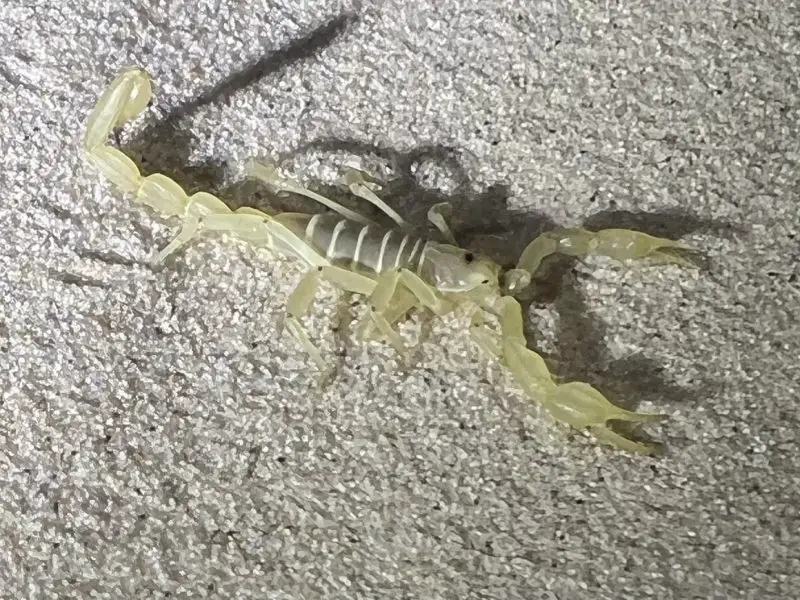
The Eastern Sand Scorpion (Paruroctonus utahensis) is a desert-dwelling species found in sandy regions across the southwestern United States. Its body coloration ranges from yellow to light brown, which allows it to blend into its surroundings perfectly. This camouflage makes it nearly invisible during the daytime.
Adapted to life on loose sand, this scorpion has swollen pincers and specialized bristles on its legs that give it traction as it moves across dune surfaces. It digs burrows near vegetation, where it hides during the heat of the day and waits for cooler temperatures to emerge and hunt.
It is a long-lived scorpion, with some individuals reaching up to seven years of age. Despite its somewhat intimidating appearance, the Eastern Sand Scorpion poses little threat to humans, and its sting is typically mild and not dangerous.
Russell’s Scorpion (Chihuahuanus russelli)
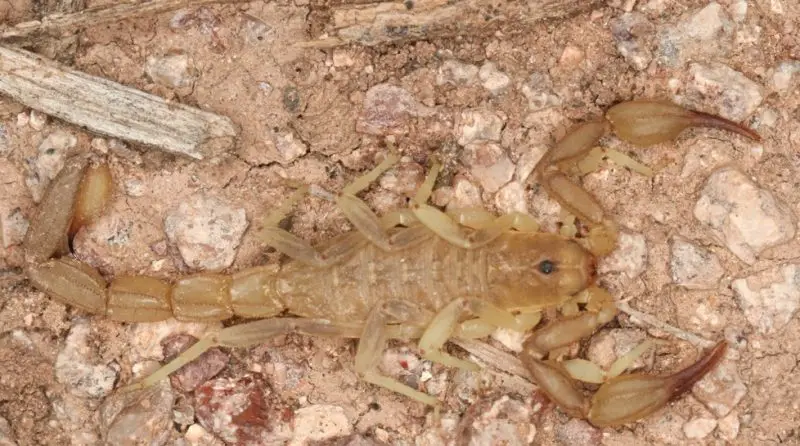
Russell’s Scorpion (Chihuahuanus russelli) belongs to the Vaejovidae family and is found in the Chihuahuan Desert regions of Arizona, Texas, and New Mexico. It has a slender body and ranges in color from reddish to light brown, helping it blend into desert soils and rocky terrain.
Males of this species grow to around 3.6 centimeters, while females can reach up to 4.1 centimeters. They prefer dry, rocky environments and are commonly found hiding under stones or debris during the day. Like most scorpions, they are nocturnal and ambush prey at night.
Though not often encountered, their venom is not medically significant. Their sting may cause minor pain or localized irritation. Much about this species remains understudied due to its secretive nature and limited sightings.
Uroctonites huachuca (Uroctonites huachuca)

Uroctonites huachuca is a relatively obscure scorpion that is only found in southern Arizona. It inhabits the sky island mountain ranges of Santa Cruz and Cochise Counties, specifically the Santa Rita and Huachuca Mountains. Its environment consists of mixed woodland and rocky outcrops at mid-elevation levels.
This species shows sexual dimorphism, with males growing to approximately 3.8 centimeters and females slightly smaller at around 3.5 centimeters. They typically hide under rocks or bark during daylight and become active at night to hunt small insects.
Like many scorpions of Arizona’s isolated mountain habitats, Uroctonites huachuca remains little known, yet it contributes to the region’s unique biodiversity. These scorpions play a key role in their ecosystems as both predators and prey in mountain forest environments.
Bryson’s Scorpion (Vaejovis brysoni)
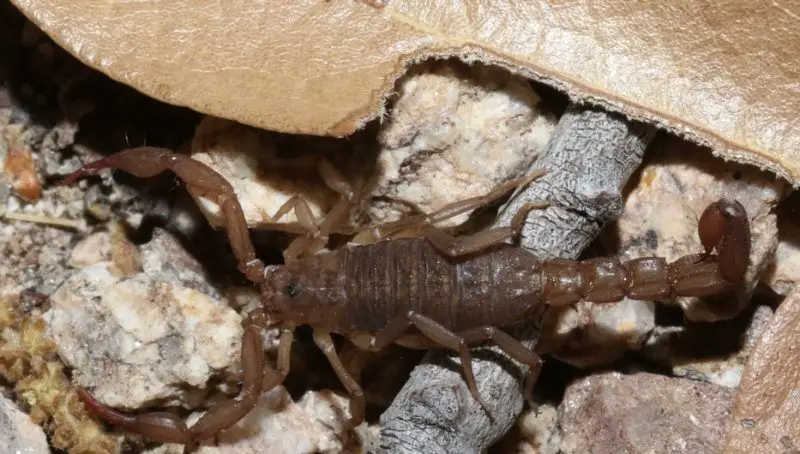
Bryson’s Scorpion (Vaejovis brysoni) is a recently discovered mountain species from the Santa Catalina Mountains in southern Arizona. Identified in 2013, this scorpion is part of the Vaejovidae family and is one of many endemic species that have been found in isolated mountain regions of the state.
This species is small in size, with females growing up to 2.75 centimeters (1.08 inches) in length. After giving birth, the female carries her young on her back until they are ready to survive on their own. This maternal behavior is common among scorpions and helps increase the survival rate of the offspring.
The discovery of Vaejovis brysoni highlights how much remains to be learned about Arizona’s mountain habitats. In just the past 15 years, the number of known mountain scorpion species in Arizona has grown from four to ten, all within the same family, showing the region’s exceptional species diversity.
Vaejovis electrum (Vaejovis electrum)
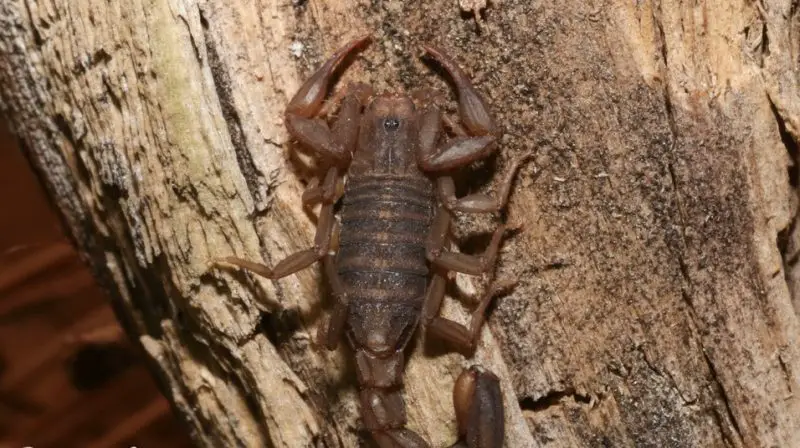
Vaejovis electrum is a scorpion species belonging to the Vaejovidae family that is endemic to Arizona, specifically found in the Pinaleno Mountains located in Graham County. This mountainous region provides a unique and isolated habitat that supports this species, which is one of the many mountain scorpions discovered in Arizona’s diverse terrain.
Males of Vaejovis electrum can grow up to 4.3 cm in total length, including the tail, making them medium-sized compared to other scorpions in the region. Their size allows them to be effective hunters of small insects and arthropods, which make up their diet. The Pinaleno Mountains’ climate and geography play a critical role in shaping the behaviors and adaptations of this scorpion.
Like many other Vaejovidae scorpions, Vaejovis electrum is nocturnal and a burrower. During the day, it hides under rocks or within burrows to avoid predators and the harsh sun, emerging only at night to hunt. This nocturnal lifestyle helps it conserve moisture and avoid the extreme heat typical of Arizona’s desert and mountain environments.
Stahnkeus allredi (Stahnkeus allredi)

Stahnkeus allredi is a scorpion species found in both Arizona and Mexico, belonging to the Vaejovidae family. In Arizona, these scorpions favor habitats that provide ample cover such as crevices under rocks, leaf litter, and the bark of trees. These microhabitats offer protection from the intense sun and predators during the day.
Females typically grow to about 1.85 cm in length, with males being slightly larger at approximately 2 cm. Their small size enables them to navigate tight spaces and remain concealed from threats. Despite their diminutive stature, they are efficient nocturnal predators that hunt small insects after nightfall.
Stahnkeus allredi is strictly nocturnal, spending daylight hours hidden and emerging under the cover of darkness. This behavior reduces their risk of dehydration and predation, common challenges in the hot Arizona environment. Their nocturnal hunting helps maintain the delicate ecological balance by controlling insect populations.
Northern Scorpion (Paruroctonus boreus)
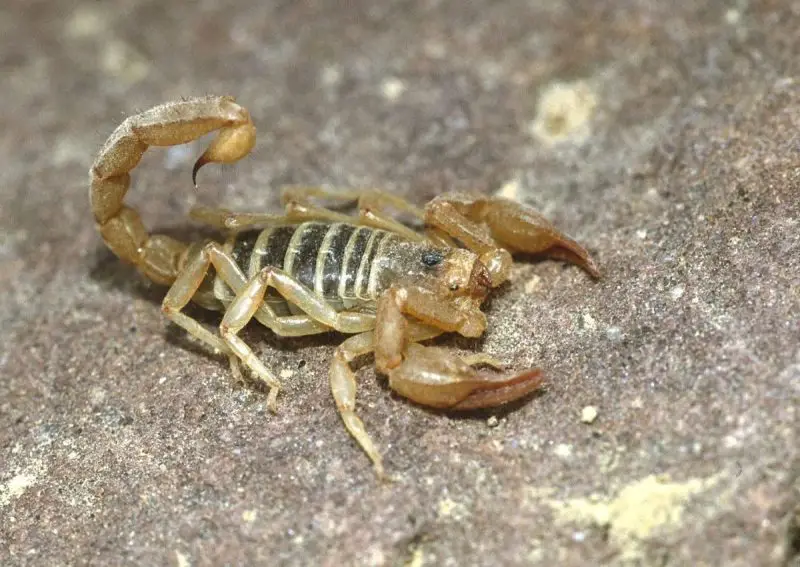
The Northern scorpion, scientifically known as Paruroctonus boreus, is part of the Vaejovidae family and is unique for its presence as the only scorpion species in Canada during dry years. However, it is more commonly found and easily observed in Arizona’s deserts. Its ability to survive in colder climates makes it an exceptional member of the scorpion family.
This species has a low-toxicity venom that generally causes mild symptoms such as swelling, pain, and redness around the sting site. These symptoms typically diminish within 24 to 72 hours. A cold compress can help reduce swelling and discomfort, making this scorpion sting manageable for most people.
In Arizona, Paruroctonus boreus is adapted to blend into its sandy and rocky surroundings, making it difficult to detect during the day when it hides to avoid predators and extreme temperatures. It typically inhabits arid regions where it can dig burrows or take refuge under stones and vegetation.
Gertschius fragilis (Gertschius fragilis)
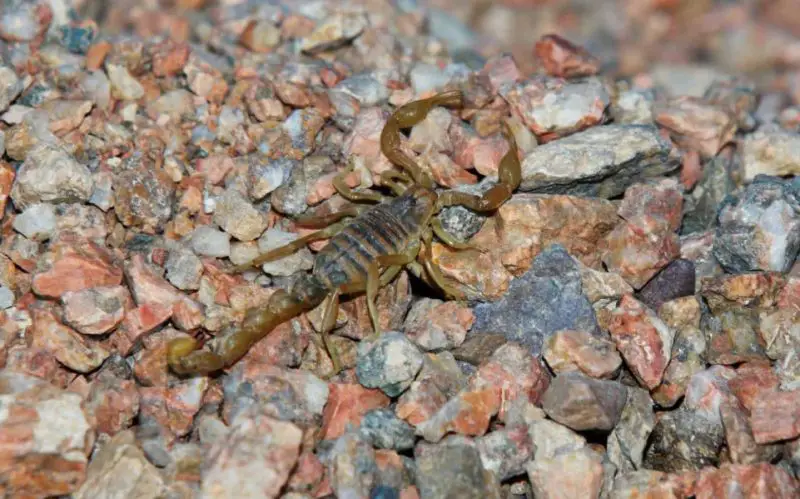
Gertschius fragilis is a small scorpion species found in both Arizona and New Mexico. Members of the Vaejovidae family, males grow to around 1.66 cm while females are slightly larger, reaching 2.28 cm.
These scorpions spend most of their days hiding in burrows or crevices, protecting themselves from predators and extreme environmental conditions. Their small size and cryptic behavior make them difficult to observe during daylight hours.
Despite their elusive nature, Gertschius fragilis contributes to the biodiversity of Arizona’s desert and semi-arid regions. Their nocturnal hunting habits help maintain insect population control within their habitats.
Wernerius mumai (Wernerius mumai)
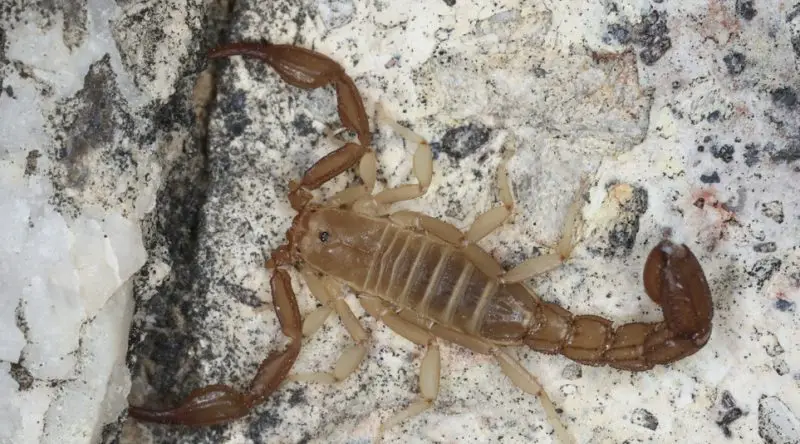
Wernerius mumai is a rare and shy scorpion species in Arizona. Observations of this scorpion are very limited, largely because it is nervous and extremely skilled at hiding. It remains hidden for most of the day, only emerging after sunset when it feels safe to hunt.
This behavior helps Wernerius mumai avoid predators and survive in the harsh desert environment. Its nocturnal nature means it is mostly active at night when temperatures drop, and prey is more available.
Though not commonly seen, Wernerius mumai adds to the complexity of Arizona’s scorpion ecosystem and represents the many secretive species that thrive in the region’s unique habitats.
Vaejovis patagonia (Vaejovis patagonia)
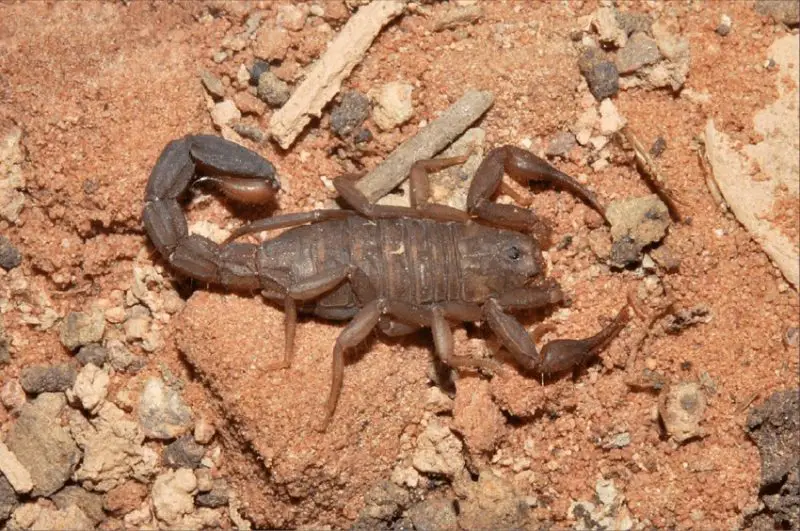
Vaejovis patagonia is a recently discovered scorpion species native to Arizona. It is characterized by its dark brown coloration and is primarily found near the Patagonia Mountains, a region known for its rugged terrain and diverse wildlife. This species adds to the unique scorpion fauna of southern Arizona.
Although detailed studies on its behavior are limited, Vaejovis patagonia likely shares similar habits with other members of the Vaejovidae family, such as nocturnal hunting and daytime hiding in burrows or under rocks. Its habitat near the Patagonia Mountains offers it protection and ample prey opportunities.
The discovery of this species highlights the rich biodiversity in Arizona’s mountainous areas and the ongoing efforts to document and understand the state’s lesser-known arachnids.
Beck’s Desert Scorpion (Paruroctonus becki)
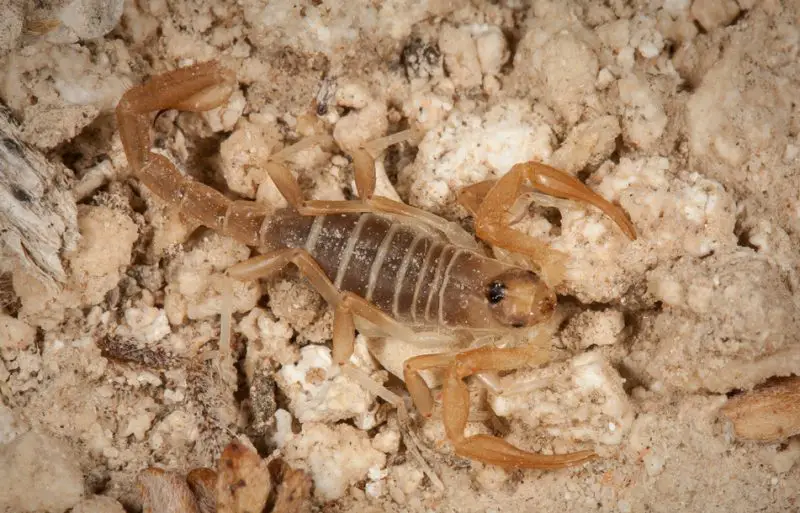
Paruroctonus becki, commonly known as Beck’s desert scorpion, was first described in 1965 and is widespread in the dry, arid regions of Arizona. This scorpion is adapted to desert life and typically burrows at the base of desert vegetation to avoid the intense heat and sun during the day.
Beck’s desert scorpion is a proficient burrower, creating shelters that provide safety from predators and extreme temperatures. Its nocturnal nature means it emerges after dark to hunt for insects and other small prey, playing a key role in the desert ecosystem.
This species is well-known among Arizona’s scorpion fauna due to its relative abundance and adaptability to harsh desert conditions, making it a familiar sight for those exploring arid areas.
Vaejovis lapidicola (Vaejovis lapidicola)
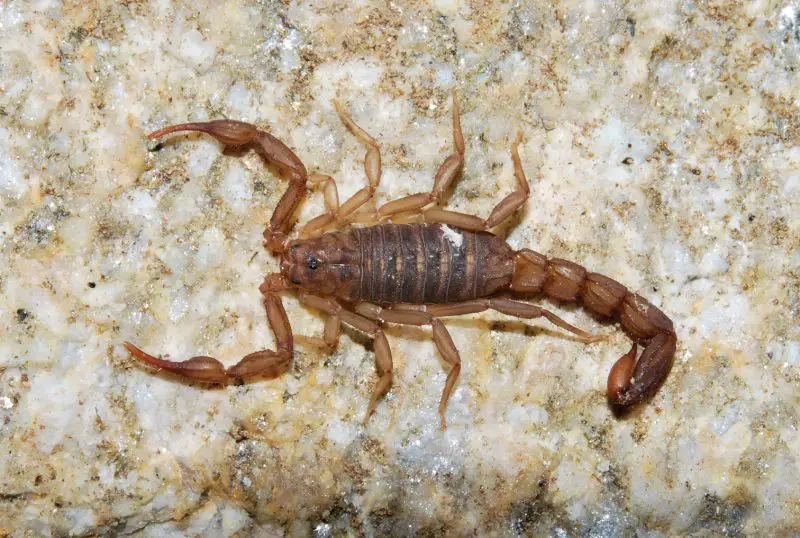
Vaejovis lapidicola is a small scorpion species within the Vaejovidae family about which little detailed information is available. It is believed to live a typical lifestyle for this family, burrowing during the daytime and becoming active at night to hunt.
Like many scorpions in Arizona, Vaejovis lapidicola likely seeks shelter under rocks, leaf litter, or soil to avoid predators and the harsh sun. Its nocturnal activity helps it catch insects and other prey that are also active during cooler nighttime hours.
Though data on this species is limited, it represents part of the rich and diverse scorpion population found in Arizona, and further research could provide insights into its habits and ecological role.
Paruroctonus stahnkei (Paruroctonus stahnkei)

Paruroctonus stahnkei is a member of the Vaejovidae family that inhabits areas in both Arizona and Mexico. In Arizona, it occupies desert and mountainous habitats where it can find shelter in rocks and sparse vegetation. This distribution highlights the species’ adaptability to different environments within the Southwest.
This scorpion species is relatively small, with males growing to approximately 2.4 cm and females slightly larger at about 2.5 cm. The slight size difference between sexes is typical for many scorpions, where females tend to be larger to support carrying offspring.
Paruroctonus stahnkei is nocturnal and hides from the harsh daytime sun and predators. Its activity peaks at night when it hunts insects and other small prey, using its sensory hairs and pincers to detect and capture food in the dark.
Kochius sonorae (Kochius sonorae)
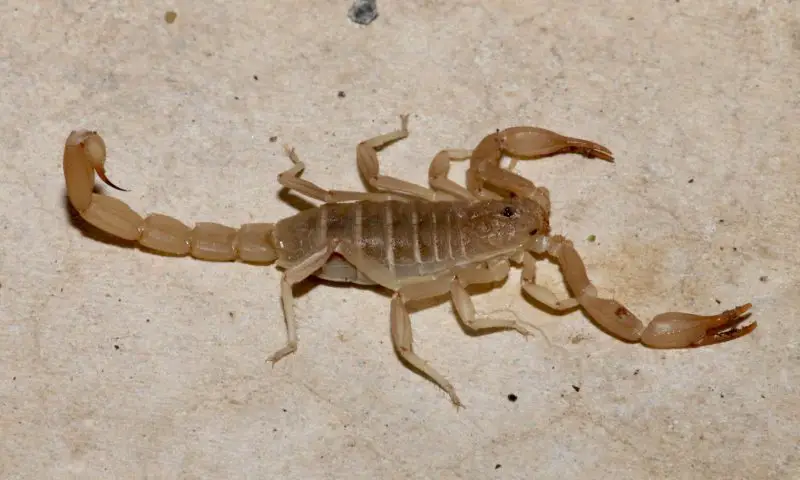
Kochius sonorae is a scorpion species primarily endemic to Mexico but also found in southern Arizona. As a member of the Vaejovidae family, it thrives in desert habitats with sandy or rocky terrain, typical of the Sonoran Desert region. The Arizona populations reflect the species’ range extending northward from Mexico.
Males of Kochius sonorae grow to about 2.8 cm in length. Though their venom is considered low toxicity and not deadly to humans, stings can cause allergic reactions in some individuals similar to bee or wasp stings. Medical attention may be necessary in such cases.
These scorpions are adapted to hot, dry climates and spend much of their time hiding under rocks or in burrows to avoid the intense sun. They are active at night, when cooler temperatures allow them to safely hunt insects and other arthropods in their desert habitat.
Thick-handed Scorpion (Chihuahuanus crassimanus)
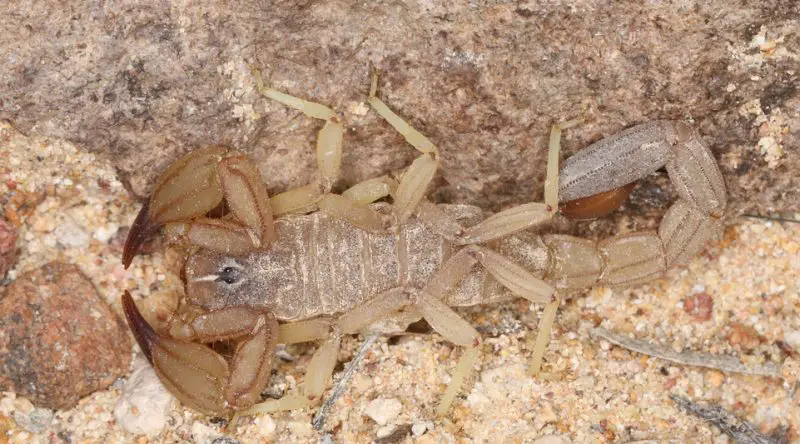
Chihuahuanus crassimanus, commonly known as the thick-handed scorpion, is found in Arizona, although sightings are quite rare. These scorpions are very shy and elusive, making them difficult to observe in the wild. Their limited observations suggest they prefer to keep hidden and avoid human contact whenever possible.
As excellent burrowers, thick-handed scorpions spend much of their time underground or under cover. They emerge mostly at night when they feel safe from predators and are able to hunt for insects and other small prey. Their nocturnal activity helps them avoid the harsh daytime conditions of Arizona’s deserts.
Due to their shy nature and low population density, little is known about their exact behavior patterns, but their presence in Arizona adds to the region’s rich scorpion biodiversity, especially in more secluded or less disturbed habitats.
Kochius hirsuticauda (Kochius hirsuticauda)

Kochius hirsuticauda scorpions inhabit several U.S. states including Arizona, California, Nevada, and Utah, and they can also be found in Mexico. In Arizona, they tend to live in dry desert environments where they can hide beneath rocks and within crevices during the hot daytime hours.
These scorpions are relatively small, reaching up to 3.2 cm in total length. They are usually only seen if disturbed, as they prefer to remain hidden and avoid encounters. However, if provoked, Kochius hirsuticauda will use its stinger to defend itself. The sting can be exceptionally painful to humans, though it is not considered deadly.
Their nocturnal habits and preference for secluded habitats make them less commonly encountered, but they play an important role as predators of insects in the ecosystems where they reside.
Paruroctonus gracilior (Paruroctonus gracilior)
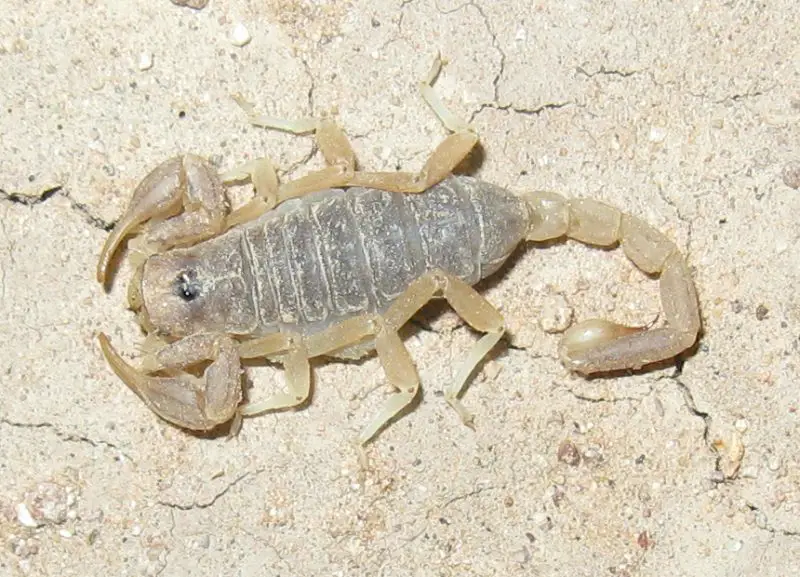
Paruroctonus gracilior is one of eight species within the Paruroctonus genus in the Vaejovidae family. Known for being shy and nervous, this species is rarely observed because it spends most of its time hiding during the day to protect itself from predators.
Found in desert regions, it prefers to avoid human contact and is primarily active at night when it hunts for prey. Its elusive nature makes detailed study difficult, but it shares many behaviors typical of other scorpions in the same family.
In Arizona, Paruroctonus gracilior contributes to the rich diversity of desert scorpions, playing an important role in controlling insect populations while maintaining the ecological balance in its habitat.
Lesser Stripetail Scorpion (Hoffmannius coahuilae)
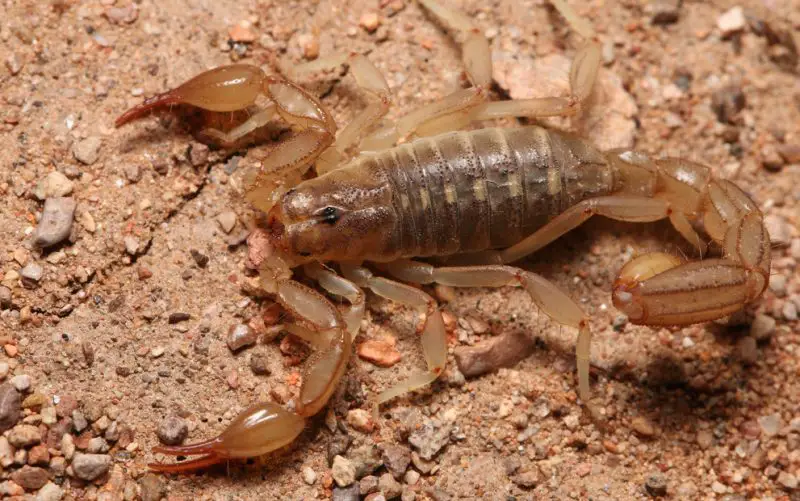
The lesser stripetail scorpion, scientifically named Hoffmannius coahuilae, closely resembles Vaejovis spinigerus, which sometimes leads to confusion between the two species. It is easily identified by its mottled carapace pattern.
This scorpion can be found in southeastern Arizona, particularly near the Chiricahua Mountains. It has also been observed in Texas, New Mexico, and northern Mexico, showing a distribution primarily in the southwestern United States and northern Mexico.
Lesser stripetail scorpions are part of the diverse scorpion fauna of Arizona and inhabit rocky desert landscapes where they seek shelter during the day and hunt at night. Their presence near the Chiricahua Mountains highlights the region’s importance as a biodiversity hotspot.
Vaejovis paysonensis (Vaejovis paysonensis)

Vaejovis paysonensis is a small scorpion species in the Vaejovidae family, observed primarily in Barbershop Canyon, Cochise County, Arizona. These scorpions are rarely seen, largely due to their shy and nervous disposition.
They tend to avoid open areas and are quick to hide when disturbed, making them elusive to casual observers. Their secretive behavior likely helps them avoid predators and harsh environmental conditions common in their habitat.
Though not commonly encountered, Vaejovis paysonensis adds to the diversity of Arizona’s scorpion populations, especially in specialized habitats like Barbershop Canyon, which offer a unique environment supporting many endemic species.
Vaejovis crumpi (Vaejovis crumpi)
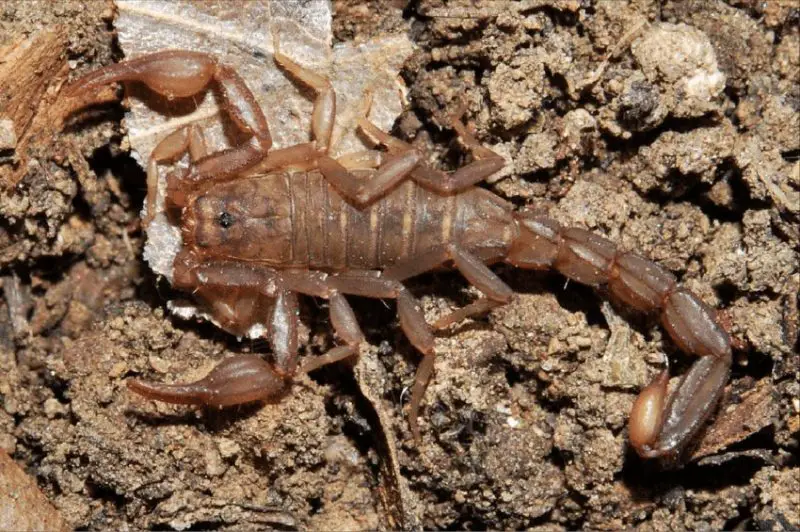
Vaejovis crumpi is a small brown scorpion native to Arizona, specifically found near Yarnell. It belongs to the Vaejovidae family and is known for its secretive behavior. During the day, it remains well hidden under rocks, tree bark, and leaf litter, blending seamlessly into its environment, which makes it very difficult to spot.
This scorpion’s preference for concealed resting spots helps protect it from predators and harsh environmental conditions common in Arizona. Its coloration aids in camouflage, allowing it to remain undetected both by prey and potential threats.
Though not commonly seen due to its discreet habits, Vaejovis crumpi plays an important role in the local ecosystem as a nocturnal predator, helping to control insect populations around Yarnell and surrounding areas.
Serradigitus wupatkiensis (Serradigitus wupatkiensis)
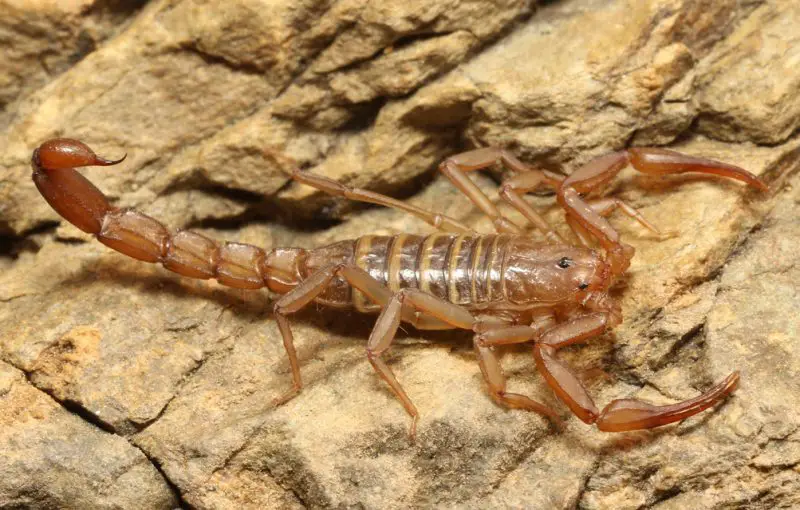
Serradigitus wupatkiensis, a sawfinger scorpion in the Vaejovidae family, is commonly found in Arizona. This genus contains more than twenty described species, many of which share similar habitats and behaviors. Serradigitus wupatkiensis typically hides beneath wood piles, rocks, leaf litter, and tree bark during the day.
This scorpion has a painful sting that is often compared to a bee sting. While the sting causes discomfort, the symptoms usually subside within 24 to 72 hours. Their nocturnal lifestyle reduces encounters with humans, although caution is advised if disturbed.
Their presence in Arizona’s diverse environments highlights the region’s rich scorpion fauna. They contribute to the natural pest control by preying on various insects during nighttime hours.
Pseudouroctonus kremani (Pseudouroctonus kremani)
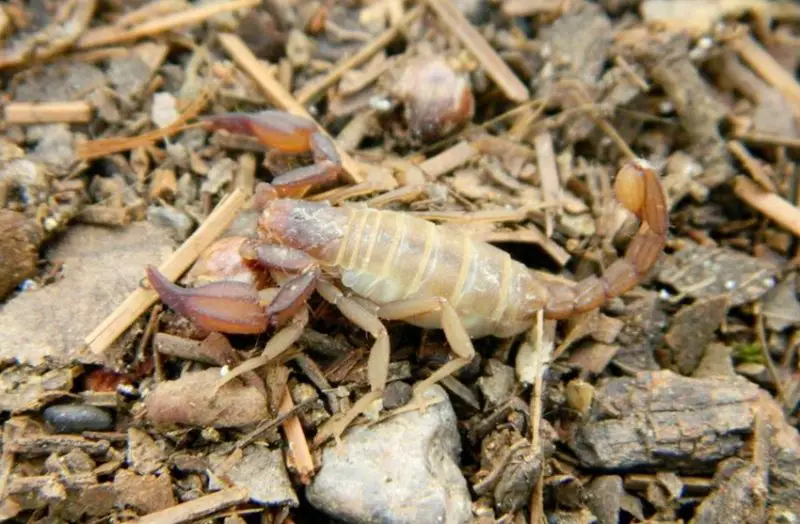
Pseudouroctonus kremani is endemic to Arizona and can be found specifically in the Santa Catalina Mountains, located in Pima County. This species belongs to the Vaejovidae family and exhibits noticeable sexual dimorphism, with females growing larger than males. Females can reach up to 3.24 cm in length, while males grow to approximately 2.48 cm.
Like many scorpions in this family, Pseudouroctonus kremani is a nocturnal hunter, spending the daylight hours hidden to avoid predators. Its presence in the Santa Catalina Mountains emphasizes the specialized habitats that Arizona’s mountain ranges provide for scorpion species.
The limited range of this scorpion makes it of interest to researchers studying endemic desert and mountain fauna, and it reflects the diversity of scorpion life adapted to Arizona’s unique environments.







Great article. One question: for Vaejovis paysonensis you mention it is found in Barbershop Canyon, Cochise County? Barbershop Canyon is in Coconino County.